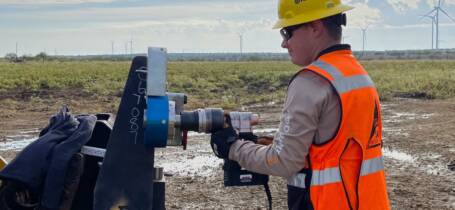
As the demand for intelligent and environmentally friendly bridge infrastructure continues to rise, the importance of meticulous planning and execution in bridge construction cannot be overstated. Bridge construction plans serve as the blueprint for realizing these vital structures, outlining every step from inception to completion.
At GWY, we understand the intricate nature of bridge construction and the critical role played by every component, down to the bolts that hold the whole thing together. Here, we discuss the critical aspects of bridge construction plans and how they intersect with the selection of the right installation tools.
What Is a Bridge Construction Plan?
A bridge construction plan is a comprehensive document outlining the entire process of designing, permitting, procuring materials, constructing and maintaining a bridge structure. It serves as both a design blueprint and a procedural roadmap for engineers, architects, contractors, government agencies and other stakeholders involved in the project.
The plan typically includes detailed information about the project objectives, scope, budget, timeline and resources required. It also addresses various technical aspects such as site analysis, design specifications, construction methodologies, safety protocols, quality assurance measures and environmental considerations.
It’s important for the construction company leading the bridge project to share the plan with their vendors, equipment suppliers and other stakeholders, so that these parties can provide the correct assets to execute the job while adhering to quality and safety standards. For larger projects, the project superintendent, project manager or construction company owner is responsible for sharing a bridge construction plan with the pertinent stakeholders; for smaller projects, the ironworkers themselves will share the plan with vendors and suppliers.
For example, the vendor supplying the structural bolting equipment needs to see the bolting plan as early as possible in the process. This plan outlines the types of bolts needed (their diameter, length, coating and lubrication), and thus the installation tools required for all bolted connections. The vendor will also need to know about any space restrictions, in case low-profile tools are needed, as well as available power sources, which informs the gauge and length requirements for corded electric tools. Securing the correct tools will help to ensure safety and structural integrity while minimizing worker burnout.
The Importance of a Bridge Construction Plan
A bridge construction plan obviously informs the design and engineering of the project, but the plan is important for a number of other reasons:
- Safety assurance
- Ensures that construction follows established safety protocols and standards.
- Minimizes risks to workers and the public during the construction process.
- Cost control
- Helps with accurate budget estimation and allocation of resources.
- Reduces the likelihood of cost overruns by identifying potential expenses upfront.
- Quality management
- Sets standards for construction quality and performance.
- Enables monitoring and inspection procedures to maintain quality throughout the project.
- Timeline management
- Establishes a clear schedule for each phase of construction.
- Facilitates coordination among various stakeholders to avoid delays.
- Regulatory compliance
- Ensures adherence to building codes, environmental regulations and safety standards.
- Helps to obtain necessary permits and approvals from regulatory authorities.
- Risk mitigation:
- Identifies potential risks and challenges associated with the construction process.
- Allows for proactive measures to mitigate risks and minimize their impact on the project.
- Efficient resource utilization
- Optimizes the use of materials, equipment and labor resources.
- Prevents waste and ensures efficient allocation of resources throughout the construction phase.
- Stakeholder alignment
- Provides a common understanding of project goals and objectives among stakeholders.
- Facilitates communication and collaboration among project team members, contractors and regulatory agencies.
- Long-term sustainability
- Considers environmental factors and sustainability principles in bridge design and construction.
- Promotes the longevity and resilience of the bridge infrastructure, reducing the need for frequent repairs and replacements.
- Public confidence
- Demonstrates professionalism and competence in project management and execution.
- Builds trust and confidence among the public and stakeholders regarding the safety and reliability of the bridge structure.
Major Bridge Building Considerations
Bridge construction plans must account for more than the engineering and technical aspects of the structure — the plan must also account for the social, scientific and technological aspects of the entire project.
Social Considerations
First, construction teams need to evaluate how the bridge (both the structure and the building process) will impact people’s lives. Will it enhance mobility and the quality of life for those who use it? How will their lives be impacted during construction, and for how long?
Project managers must take precautions to reduce noise and pollution while enhancing safety, during both the construction and post-construction phases. For example, utilizing quieter tools during construction, particularly in busy areas, can significantly improve worker productivity and safety while minimizing disruptions to the surrounding community.
It’s also crucial to understand the cost versus benefits to the community, including taxes, tolls and the potential for economic development (or decline) due to changes in access. To keep costs down, teams can make use of available resources and conditions, thereby mitigating environmental impact and optimizing material consumption. For example, using locally sourced stone, gravel or timber can reduce transportation costs and support the local economy.
Scientific Considerations
Bridge design relies heavily on physics principles, and any natural forces that would potentially compromise the structure’s integrity — such as weather, waterways or soil quality — need to be thoroughly understood. Mathematical calculations are used to determine the forces and stressors acting on the bridge, which in turn guide its design and construction.
Construction teams should understand the environmental implications of the bridge design and materials they use, and whether they could pose a threat to human, animal or plant life. For example, does the design allow for wildlife to pass over or under the bridge with minimal disruption to traffic or pedestrians? What is the chemical impact of the paint or bolt lubrication as it leaches into the soil or waterways over time?
Technological Considerations
To maximize quality and efficiency, construction teams should incorporate the most cutting-edge design, materials, construction techniques and workforce management strategies available. Scale models are used to conduct weight capacity and aerodynamic studies that will help ensure ultimate safety.
Bridge designs can also be tailored to leverage natural features and environmental conditions. For instance, teams can incorporate the natural topography of the area to strengthen structural integrity and minimize the need for extensive earthworks and excavation. By working with, rather than against, the environment, construction teams can reduce disruption to ecosystems and habitats while using available resources.
Key Aspects to Include in a Bridge Construction Plan
Key components of a bridge construction plan include:
- Project objectives and scope: Defines the purpose and goals of the bridge, including its intended use, capacity and geographical location
- Site analysis and feasibility study: Evaluates the suitability of the construction site based on factors such as soil conditions, topography, hydrology and environmental impact
- Design and engineering plan: Specifies the structural design, materials, dimensions and technical specifications of the bridge based on engineering principles and standards
- Regulatory compliance measures: Ensures compliance with local, state and federal regulations, including building codes, zoning ordinances, environmental laws and permitting requirements
- Budget and resource allocation plan: Estimates the project cost, allocates resources (e.g., materials, equipment, labor) and establishes a financial plan for the entire construction process
- Construction methodology: Outlines the construction methods, techniques, sequences and schedules for building the bridge structure while considering safety, efficiency and quality control
- Safety plan: A safety plan to protect workers, the public, and the environment during all phases of construction, including training, emergency procedures and hazard mitigation measures
- Quality assurance and control procedures: Outlines procedures to ensure that the bridge meets design specifications, regulatory requirements and industry standards
- Environmental protection measures: Outlines steps taken to minimize environmental impact, mitigate pollution, preserve natural habitats and comply with environmental regulations throughout the construction process
- Risk management plan: Identifies potential risks, hazards and challenges associated with bridge construction and develops strategies to mitigate and manage them effectively
- Communication and coordination plan: Establishes communication protocols, collaboration mechanisms and reporting structures among project stakeholders to facilitate effective coordination and decision making
- Post-construction maintenance plans: Outlines plans for ongoing maintenance, inspection, repair and rehabilitation of the bridge structure to ensure its long-term durability, safety and functionality.
Creating a Bridge Construction Schedule
A bridge construction schedule is crucial for keeping the project on track and maximizing the use of available time and resources. While the details will vary depending on location, project scope and available resources, the schedule should follow the same basic timeline:
- Project initiation and planning
- Identify the need for the bridge
- Define the purpose and scope of the bridge
- Conduct site surveys and feasibility studies, including a traffic assessment
- Determine the budget, timeline and resources needed
- Obtain necessary permits and approvals from regulatory authorities
- Study, refine, conceptualize and shortlist all possible alternatives
- Complete preliminary engineering
- Design phase
- Hire a team of engineers, architects and designers
- Develop conceptual and detailed designs based on site conditions, traffic requirements and environmental factors
- Consider various structural options such as beam, arch, suspension or cable-stayed bridges
- Develop a plan for all bolted structural connections
- Perform structural analysis and simulations to ensure safety and efficiency
- Develop design plans
- Procurement
- Identify material sources
- Procure materials, equipment and services required for construction
- Solicit bids from contractors and subcontractors
- Evaluate proposals and award contracts based on cost, quality and experience.
- Pre-construction activities
- Clear the construction site and prepare the foundation
- Set up temporary facilities such as construction offices, storage areas and worker accommodations
- Establish safety protocols and environmental protection measures
- Construction phase
- Begin construction of substructures, such as abutments and piers, using methods like pile driving or concrete pouring
- Erect superstructures, including bridge decks and supporting elements
- Install utilities such as lighting, drainage systems and guardrails
- Monitor construction progress, quality and safety compliance
- Quality assurance and control
- Conduct regular inspections and testing of materials and structural components
- Address any issues or deviations from the design plans promptly
- Ensure compliance with building codes, standards and specifications
- Completion and commissioning
- Finish the bridge construction, including surface treatments and landscaping
- Conduct final inspections and tests to verify structural integrity and safety
- Obtain certification and approval from relevant authorities
- Plan for the opening ceremony and public inauguration
- Post-construction maintenance:
- Develop a maintenance plan for routine inspections, repairs and upgrades
- Monitor the bridge’s performance over time and address any deterioration or wear
- Implement measures to extend the lifespan of the bridge and ensure continued safety for users
No matter how massive or small-scale the project is, every detail matters in bridge construction. Partnering with the right vendors and suppliers can help ensure the utmost in structural integrity, down to the smallest components.
At GWY, we have a wide range of structural bolting equipment available, from Turn-of-Nut wrenches to torque tools to safety accessories, all fabricated to meet the exacting demands of bridge construction projects. Contact us today to learn how we can support your bridge construction plans with precision and reliability.



